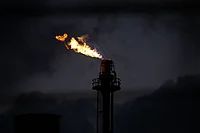Oil Falls After Industry Report Shows Surprise U.S. Supply Rise
Oil surged toward $63 a barrel with investment banks and traders predicting the market will tighten further.

(Bloomberg) -- Oil declined in New York after an industry report showed U.S. crude stockpiles rose last week amid a spate of refinery outages from the country’s recent cold snap.
The industry-funded American Petroleum Institute was said to report a 1.03 million-barrel build in domestic oil inventories, compared to expectations for a decline. At the same time, U.S. drillers have already restored about 80% of crude production in parts of Texas following the polar blast.
“People have been counting on continuous drawdowns, so there will be these surprise builds on occasion,” said Phil Streible, chief market strategist at Blue Line Futures LLC in Chicago.

Technical indicators were also showing a pullback in benchmark crude prices was overdue after they jumped 18% this month. The rally has been supported by production cuts from Saudi Arabia and an improving outlook for demand.
The futures curve continues to reflect tightening supplies, with Brent’s nearest contracts trading at a premium to later ones in a bullish pattern known as backwardation. The market is pricing in a strong short-term deficit, as oil stockpile declines continue at a rate of 2 million barrels a day to 3 million barrels a day, according to Vitol Group.
Meanwhile, Saudi Arabia and Russia will once again head into an OPEC+ meeting with differing opinions about adding more crude to the market, potentially pressuring the recent rally. Saudi Arabia is calling for caution while Moscow appears to favor a supply hike. The group will meet March 4 to discuss whether to provide more crude to the market in April.
“It’s unmistakable that we’ll see some increase, but how much we get” is still uncertain, said Bill O’Grady, executive vice president at Confluence Investment Management in St. Louis. “The Saudis like this price level a lot, because it’s high enough where they generate good levels of income but low enough to where they don’t anticipate a huge pickup in U.S. production.”
| Prices |
|---|
|
Crude production from the Texas portion of the Permian Basin has rebounded significantly to around 2.9 million barrels a day, from just 600,000 to 700,000 exactly a week ago, according to Bert Gilbert, head of North American business development at oil-data analytics startup OilX. Typically, the area produces roughly 3.5 million barrels a day.
“This recovery is largely due to a return of electricity to the region,” Gilbert said.
The API report showed stockpiles grew at the nation’s largest storage hub in Cushing, Oklahoma, and gasoline inventories also rose. The U.S. government will report its storage figures on Wednesday.
Other energy infrastructure impacted by the U.S. deep freeze is also in the process of restarting. Plains All American Pipeline LP plans to restore normal operations at 16 oil pipelines after notifying users last week of a force majeure, according to a person familiar with the matter, while at least eight refineries in Texas were trying to restart as of early Tuesday, with varying degrees of success.
| Other oil-market news: |
|---|
|
©2021 Bloomberg L.P.